Posted by Elena del Valle on May 19, 2021
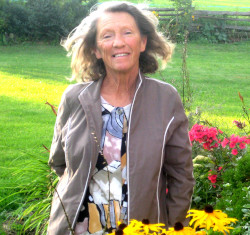
Elizabeth Lauder at Stanley Park
Photos: Abernathy & Smyth Publishing
The work of Elizabeth Cameron Lauder, a Canadian artist known for her oil on semi-precious stone and watercolors, is featured posthumously in two recently published softcover books: Elizabeth Lauder: Memoirs of a Plein Air Painter Volume One Watercolors (Abernathy & Smyth Publishing, $59.95) and Volume Two Oil on Semi-Precious Stone (Abernathy & Smyth Publishing, $69.95) edited by J.R. Boleyn, her life partner. Two additional volumes completing the series of four are scheduled to be published by year’s end.
Volume One includes 125 color images and Volume Two includes 200 images. Most pages feature a single image of her art. Many of the photos were taken and selected for inclusion by the artist, according to Boleyn who responded to questions via email.
“What defines Elizabeth, and separates her from other artists in that regard, was her ability to incorporate the stone itself as part of the final painting,” said Boleyn. “A prime example of that is the painting titled ‘Renaissance Girl’ (Volume One, page 117) where the wreath around the subjects head is the actual rubies embedded in the imperial jade stone. This made Elizabeth’s work unique in all the world, and why it became so valuable. She was the first!”

Elizabeth Lauder Volume One
All of her rock paintings in Volume Two and watercolors in Volume One have been previously sold to private collectors in over eighty countries. The artist owned a studio in Quartzsite, Arizona a town known for its international gem and mineral shows.
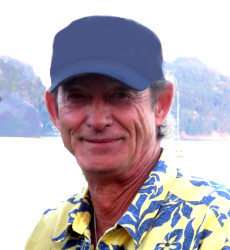
J.R. Boleyn, publisher, Abernathy & Smyth
“I have in my personal collection, which will be featured in her ‘Volume Three’ to be published by late summer, over 200 originals that will be for sale,” said Boleyn. “Yes, they are all watercolors, over 200 signed originals ranging in size from 8 x 11 to 22 x 30 and sizes in between, priced at a minimum $550 for the smallest to $4,500 for the larger sizes.”
According to promotional materials, she is a relative of film director James Cameron. Her work has been exhibited around the world and sold through Sotheby’s Fine Art Auctions and Sotheby’s Private Contemporary Artist’s Sales in New York and London. Her art has been collected by patrons in over eighty countries around the world, according to a press release that also indicates Elizabeth’s watercolors are currently under consideration for permanent exhibition in the National Gallery of Canada.

Elizabeth Lauder Volume Two
The art was compiled by Boleyn, an American songwriter, author, and founder of Abernathy and Smyth. Born April 8, 1948, in Ontario, Elizabeth’s first 18 years were spent growing up on a farm in the Caledon Hills where she was inspired by pastoral landscapes and abrupt and beautiful dramatic seasonal changes. Her formal education was completed in 1971 with an associate’s degree in sculpture from the Ontario College of Art and Design. The following year Elizabeth moved to the west coast, trading chisels and bronze for brushes and palette.
Already distinguished for her watercolors of Vancouver’s cherry blossoms, she spent the next seven years traveling throughout Mexico and painting southwest mining scenes. According to her website she was inspired by her travels to paint on massive slabs of semi-precious stone.
Comments:
Filed Under: Books
Posted by Elena del Valle on May 3, 2021
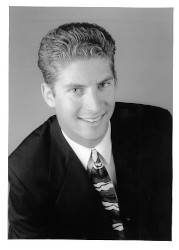
Tony Hereau, vice president of Cross-Platform Insights, Nielsen
Photo: Nielsen
A podcast interview with Tony Hereau, vice president of Cross-Platform Insights, Nielsen, is available in the Podcast Section of Hispanic Marketing and Public Relations, HispanicMPR.com. He discusses podcast insights with Elena del Valle, host of the HispanicMPR.com podcast.
In his job Tony strives to demonstrate the impact that audio has on media investment, marketing execution, and sales outcomes. He has over 20 years of experience in the buying and selling of media, championed the radio reach story via the Total Audience Report, and most recently developed a measurement service for the podcasting industry.
To listen to the interview, scroll down and click on the play button below. You can listen by looking for “Podcast” then select “HMPR Tony Hereau” and download the MP3 file to your audio player. You can also find it on the RSS feed. To download it, click on the arrow of the recording you wish to copy and save it to disk. The podcast will remain listed in the May 2021 section of the podcast archive.
Posted by Elena del Valle on April 19, 2021
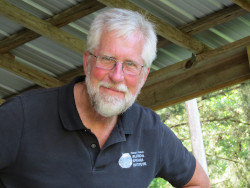
Robert Knight, P.h.D., director, Florida Springs Institute
Photo: Florida Springs Institute
A podcast interview with Robert Knight, P.h.D., director, Florida Springs Institute, is available in the Podcast Section of Hispanic Marketing and Public Relations, HispanicMPR.com. During the podcast, he discusses the impact of groundwater withdrawals to Florida springs with Elena del Valle, host of the HispanicMPR.com podcast. Scroll down for a PDF file to accompany the podcast.
Bob is the founder of the Howard T. Odum Florida Springs Institute, “a nonprofit program dedicated to supporting science and education necessary for restoration and wise management of Florida’s artesian springs.” He is an environmental scientist with more than 38 years of professional experience in Florida, including detailed ecological studies at more than 20 large springs. He is former adjunct professor at the University of Florida Department of Environmental Engineering and Sciences where he taught graduate level classes on the ecology of Florida’s springs and wetlands.
To listen to the interview, scroll down and click on the play button below. You can listen by looking for “Podcast” then select “HMPR Robert Knight, P.h.D.” and download the MP3 file to your audio player. You can also find it on the RSS feed. To download it, click on the arrow of the recording you wish to copy and save it to disk. The podcast will remain listed in the April 2021 section of the podcast archive.
Click here for PDF file.
Posted by Elena del Valle on March 8, 2021
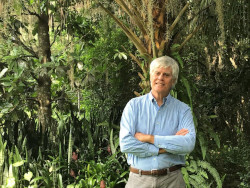
John Dunn, author, Drying Up
Photo: Susan Dunn
A podcast interview with John Dunn, author, Drying Up (see Writer examines Florida water issues), is available in the Podcast Section of Hispanic Marketing and Public Relations, HispanicMPR.com. During the podcast, he discusses the fresh water crisis in Florida with Elena del Valle, host of the HispanicMPR.com podcast. Scroll down for slide materials and Drying Up Handout.
A native Miamian, John has written more than 400 articles for Europe, Overseas Life, Sierra, Florida Trend, Business Florida, and The St. Petersburg Times. He authored 16 non-fiction young adult books. He has also edited a Civil War series for young readers.
In February 2019, Drying Up The Fresh Water Crisis in Florida was selected as winner of the Florida Historical Society’s Stetson Kennedy Award for writing about Florida’s natural environment. The book also won the Bronze Medal in the 2019 Florida Book Awards, Florida Nonfiction category.
To listen to the interview, scroll down and click on the play button below. You can listen by looking for “Podcast” then select “HMPR John Dunn” and download the MP3 file to your audio player. You can also find it on the RSS feed. To download it, click on the arrow of the recording you wish to copy and save it to disk. The podcast will remain listed in the March 2021 section of the podcast archive.
John Dunn Slides
Drying Up handout
Posted by Elena del Valle on March 1, 2021

John Incledon, president, Hisamitsu America
Photo: Andrew Foord
A podcast interview with John Incledon, president, Hisamitsu America, is available in the Podcast Section of Hispanic Marketing and Public Relations, HispanicMPR.com. During the podcast, he discusses his company’s success with topical pain relief products in the Hispanic market with Elena del Valle, host of the HispanicMPR.com podcast.
John is also chief executive officer of Hisamitsu America. According to his biography he has a broad background in marketing, new product development, management, team building, global commercialization, sales, in-licensing, and acquisitions and divestitures.
To listen to the interview, scroll down and click on the play button below. You can also listen by looking for “Podcast” then select “HMPR John Incledon” and or download the MP3 file to your iPod or MP3 player to listen on the go, in your car or at home. You can also find it on the RSS feed. To download it, click on the arrow of the recording you wish to copy and save it to disk. The podcast will remain listed in the February 2021 section of the podcast archive.
Posted by Elena del Valle on February 22, 2021

Erika Benson, co-owner, Gokce Capital LLC
Photo: Gokce Capital LLC
A podcast interview with Erika Benson, co-owner, Gokce Capital LLC, is available in the Podcast Section of Hispanic Marketing and Public Relations, HispanicMPR.com. During the podcast, she discusses how to invest in vacant land in 2021 with Elena del Valle, host of the HispanicMPR.com podcast.
Erika, a former affordable housing director for the City of New York, is now a full-time land investor. The article and podcast with part one of this topic was published January 25, 2021.
To listen to the interview, scroll down and click on the play button below. You can also listen by looking for “Podcast” then select “HMPR Erika Benson” and or download the MP3 file to your iPod or MP3 player to listen on the go, in your car or at home. You can also find it on the RSS feed. To download it, click on the arrow of the recording you wish to copy and save it to disk. The podcast will remain listed in the February 2021 section of the podcast archive.
Posted by Elena del Valle on January 25, 2021

Erika Benson, co-owner, Gokce Capital LLC
Photo: Gokce Capital LLC
We have a new podcast player. See the top of the page.
A podcast interview with Erika Benson, co-owner, Gokce Capital LLC, is available in the Podcast Section of Hispanic Marketing and Public Relations, HispanicMPR.com. During the podcast, she discusses how to invest in vacant land in 2021 with Elena del Valle, host of the HispanicMPR.com podcast.
Erika is a former affordable housing director for the City of New York turned full-time Land Investor. She used to help New Yorkers find affordable housing, now she helps people around the United States find affordable land.
She keeps an active blog on the company website where she gives out advice on buying and selling land. She has a YouTube channel with over 250 videos that provide tips for land buyers and information on the company properties.
To listen to the interview, scroll down and click on the play button below. You can also listen by looking for “Podcast” then select “HMPR Erika Benson” and or download the MP3 file to your iPod or MP3 player to listen on the go, in your car or at home. You can also find it on the RSS feed. To download it, click on the arrow of the recording you wish to copy and save it to disk. The podcast will remain listed in the January 2021 section of the podcast archive.
Posted by Elena del Valle on January 19, 2021
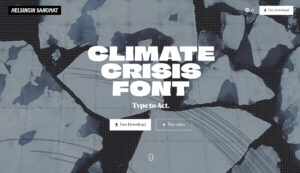
The Climate Crisis Font English language landing page – click to enlarge
Video, photos: Helsingin Sanomat
Photo Tuomas Jääskeläinen: Juha Törmälä
Helsingin Sanomat
, “the biggest subscription-based newspaper in the Nordics,” dedicated several weeks of work spread over months to the development of The Climate Crisis Font designed to visualize the urgency for climate action. The new font is available for download free of charge at TypeToAct.com. Scroll down to watch an English language video.
“The font has been licensed with SIL Open Font licensing making it available for editorial, commercial, and private use,” said Tuomas Jääskeläinen, art director, Helsingin Sanomat, in response to questions through a communications intermediary via email.” The full terms of use are available at drive.google.com/file/d/19M8ebCT0JOLWln6LDkWQzj5gy-qmj9Ww/view.

The Climate Crisis Font designed to visualize the urgency for climate action – click to enlarge
“The main limitation is that it needs to be kept freely available and free of charge,” he said. “The font is intended for anyone who wishes to make a point about the impact of climate change, be it the media, designers, artists, activists or anyone else.” He explained that “the font has been designed to work in all latin-based alphabets when it comes to e.g. diacritics.
.
When asked other than drawing attention to climate action what makes the font special or distinctive he replied: “
I think it’s the fact that it’s based on actual data. We haven’t done a massive search, but I suspect it’s among the first data-based fonts in the world, if not the first. That, and the way the scalable OpenType technology lets the font align with the yearly data, is what makes it special for me.”
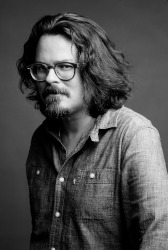
Tuomas Jääskeläinen, art director, Helsingin Sanomat
Regarding the budget or budget range for the creation of the font he said: “
Unfortunately I cannot disclose the budget, but it is a reasonable investment considering the scope of work needed.”
Helsingin Sanomat, a private for profit entity, is published by Sanoma Media Finland, a leading Finnish multi-channel media company. The paper’s primary language is Finnish.
Posted by Elena del Valle on January 6, 2021
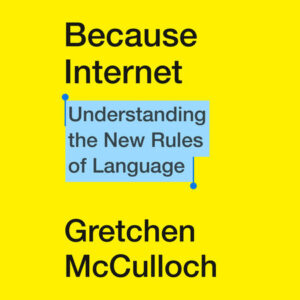
Because Internet
Photo: Riverhead Books
Ending a text with a period may make the writer seem old while an emoticon at the end of a sentence can add surprising nuance to the statement, according to a book about language published last year. The subtleties of informal written communication are many, says Gretchen McCulloch, a self described internet linguist. She believes modern digital communications are changing language and the way we and society overall communicate for the better. In Because Internet: Understanding the New Rules of Language (Riverhead Books, $26) she explains her views and theories.
Salutations like language in general evolve over time, according to the book. McCulloch explains that for many addressing someone with dear has become dated. At the same time hey, which for older generations is objectionable, has become a common written email greeting. Hi follows in popularity with hello being last and used to address strangers.
The author goes on to say that a generational gap exists; and some users embrace the “expressive capacity” of informal writing while others reject it. The author explains the difference between emoticons, emojis and gifs, pointing out that although there is no universal agreement on their appearance emojis are the best fit for many people communicating electronically. They make it possible for users to better express their mental states in written form, the author says. It’s useful to think of emojis as gestures; already courts have had to address the meaning of emojis such a raised hand, a possible gang sign or a comma, she says.
The 326-page hardcover book published in 2019 is divided into eight chapters: Informal Writing, Language and Society, Internet People, Typographical Tone of Voice, Emoji and Other Internet Gestures, How Conversations Change, Memes and Internet Culture and A New Metaphor. The emojis in the book are from Twemoji, an open source font released under a Creative Commons Attribution.
McCulloch, is based in Montreal, Canada and hosts the podcast Lingthusiasm, according to her bio.
Comments:
Filed Under: Books
Posted by Elena del Valle on December 16, 2020
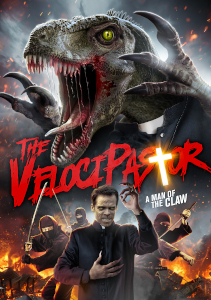
The Velocipastor poster
Photos: Filmocracy
Established in 2018 Filmocracy offers 2,800 independent films in a variety of genres in shorts, documentaries, feature length and series, except music videos, for an audience mainly between 25 and 40 years of age. The selection includes foreign language films with subtitles. One film, Road To Your Heart, was in Afrikaans without subtitles.
“Filmocracy is the only site that offers virtual film festivals and also rewards users for watching and rating movies,” said Paul Jun, chief executive officer, Filmocracy, by email when asked what makes the streaming platform stand out. “Users earn virtual popcorn which they can spend in our shop on things like gift cards, movie tickets, and festival passes. Most of our subscribers come through the virtual film festivals we host.”

Paul Jun, chief executive officer, Filmocracy
According to the website subscriptions range from free with ads to Festival Premium for $29.99 a month. Most of the 17,000 users are in the United States, mainly Los Angeles and New York, with large user groups in Spain, India, and Brazil, according to Jun.
Eight categories of rating options (Plot, Characters, Cinematography, Performances, Dialogue, Sound/Music and Overall) appeared whenever I paused the videos. A rating number appeared at the top of videos that had been rated. As of this writing a drop down menu at the top of the homepage listed eleven categories. There were also featured films and upcoming virtual film festivals, including the Blastoff Film Festival, DC Chinese Film Festival, Diorama Film Festival, Around Films International Film Festival Barcelona for the remainder of 2020.
The three most watched films in 2020? The Velocipastor, Temp to Perm (disturbing short), and Extra Innings. Top genres in number of films: Drama, Documentary. The company markets mostly on FaceBook, Twitter and YouTube. In addition to Jun the Los Angeles based company is owned by Kasia Jun Kaczmarczyk, Phillip Jun, Pawel Drzewiecki, and Jasper Grey.
























